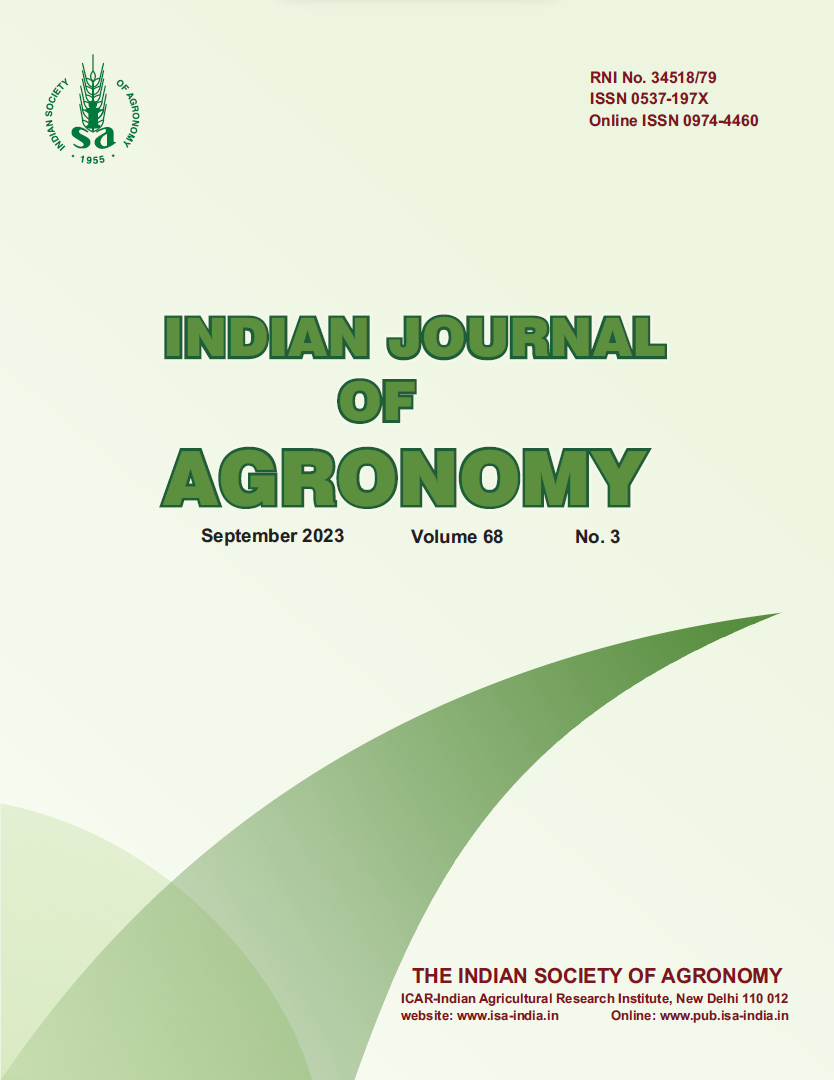Energy consumption and its indices under different tillage methods in mungbean (Vigna radiata)–wheat (Triticum aestivum) system in semi-arid conditions of Haryana
DOI:
https://doi.org/10.59797/ija.v68i3.2806Keywords:
Energy use, Mungbean, Wheat, Yield, Zero-tillageAbstract
A field experiment was conducted during 2019–20 and 2020–21 at the Chaudhary Charan Singh Haryana Agricultural University, Regional Research Station, Bawal (Rewari), to study the energy consumption and indices under different tillage methods in mungbean (Vigna radiata (L.) R. Wilczek)–wheat (Triticum aestivum L.) cropping system. The treatments included 9 tillage combinations for crop establishment under mungbean–wheat cropping system (MWCS), viz. zero-tillage mungbean (ZTM) followed by (fb) zero-tillage wheat (ZTW), ZTM fb reduced tillage wheat (RTW), ZTM fb conventional tillage wheat (CTW), reduced tillage mungbean (RTM) fb ZTW, RTM fb RTW, RTM fb CTW, conventional tillage mungbean (CTM) fb ZTW, CTM fb RTW, CTM fb CTW, laid out in randomized block design with 3 replications. The yields of mungbean sown after ZTW were higher (775–785 kg/ha) than after RTW (756–783 kg/ha) or CTW (753–780 kg/ha). However, the highest grain yield (5,367 and 5,025 kg/ha during 2019–20 and 2020–21, respectively) of wheat was obtained under ZTM–ZTW. Energy inputs under ZTM–ZTW were lowest, which saves 18% of energy incurred in CTM–CTW. Output: input ratio of energy was highest (10.13) under ZTM–ZTW and lowest (7.67) under CTM–CTW. Zero-tillage resulted in the minimum specific energy (energy consumed/kilogram of grain production) in mungbean (4.37–5.16 MJ/kg) and wheat (2.94–3.10 MJ/kg). Zero-tillage based establishment of MWCS was realized to be sustainable for resource conservation as well as crop productivity.
References
Ali, S.A., Tedone, L. and Mastro, G.D. 2013. A comparison of the energy consumption of rainfed durum wheat under different management scenarios in southern Italy. Energy 61: 308– 318.
Borin, M., Merini, C. and Sartori, L. 1997. Effects of tillage systems on energy and carbon balance in north-eastern Italy. Soil and Tillage Research 40(3): 209–226.
Canakci, M., Topakci, M., Akinci, I. and Ozmerzi, A. 2005. Energy use pattern of some field crops and vegetable production: Case study for Antalya Region, Turkey. Energy Conversion and Management 46: 655–666.
Cochran, W.G. and Cox, G.M. 1959. Experimental Designs. John Wiley Pub., New York, USA.
Coventry, D.R., Poswal, R.S., Yadav, A., Gupta, R.K., Gill, S.C., Chhokar, R.S., Kumar, V., Sharma, R.K., Kumar, A., Mehta, A., Kleemann, S.G.L. and Cummin, J.A. 2011. Effect of tillage and nutrient management on wheat productivity and quality in Haryana, India. Field Crops Research 123: 234– 240.
Hülsbergen, K.J., Feil, B., Biermann, S., Rathke, G.W., Kalk, W.D. and Diepenbrock, W. 2001. A method of energy balancing in crop production and its application in a long-term fertilizer trial. Agriculture, Ecosystems and Environment 86: 303–332.
Kassam, A.H. and Friedrich, T. 2009. Perspectives on nutrient-management in conservation agriculture. (In) Abstracts of 4th World Congress on Conservation Agriculture, 4–7 February 2009, New Delhi, India, pp. 7.
Malik, R.K., Kumar, V., Yadav, A. and MacDonald, A. 2014. Conservation agriculture and weed management in South Asia: Perspective and development. Indian Journal of Weed Science 46(1): 31–35.
Ozkan, B., Akcaoz, H. and Fert, C. 2004. Energy input output analysis in Turkish agriculture. Renewable Energy 29: 39–51.
Pacharne, D.P. 2017. Production potential and energy dynamics of efficient cropping systems under diverse nutrient management practices. Indian Journal of Agronomy 62(3): 280–286.
Parihar, C.M., Jat, S., Singh, A.K., Kumar, B., Rathore, N S., Jat, M.L., Saharawat, Y. and Kuri, B.R. 2018. Energy auditing of long-term conservation agriculture based irrigated intensive maize systems in semi-arid tropics of India. Energy 142: 289–302.
Pathak, B. S. and Binning, A.S. 1985. Energy use pattern and potential for energy saving in rice-wheat cultivation. Agriculture and Energy 4: 271–278.
Sharma, R.K., Chhokar, R.S., Chauhan, D.S., Gathala, M.K., Rani, V. and Kumar, A. 2002. Paradigm tillage shift in rice–wheat system for greater profitability. (In) Malik, R.K., Balyan, R.S., Yadav, A., and Pahwa, S.K. (Eds). Herbicide Resistance Management and Zero Tillage in Rice–Wheat Cropping System. Chaudhary Charan Singh Haryana Agricultural University, Hisar, pp. 131–135.
Sheoran, O.P, Tonk, D.S., Kaushik, L.S., Hasija, R.C. and Pannu, R. S. 1998. Statistical Software Package for Agricultural Research Workers. (In) Hooda, D.S. and Hasija, R.C. (Eds). Recent Advances in Information Theory, Statistics and Computer Applications. Chaudhary Charan Singh Haryana Agricultural University, Hisar, pp. 139–143.
Singh, J.M. 2002. On farm energy use pattern in different cropping systems in Haryana, India. Master of Science, International Institute of Management University of Flensburg, Germany.
Tabatabaeefar, A., Emamzadeh, H., Varnamkhasti, M.G., Rahimizadeh, R. and Karimi, M. 2009. Comparison of energy of tillage systems in wheat production. Energy 34: 41– 45.
Yadav, A., Malik, R.K., Balyan, R.S., Malik, R.S., Jaipal, S., Phogat, V.K., Singh, R., Dabur, K.R., Dharam-Bir and Kumari, K. 2012. Impact of long-term zero-tillage on productivity and sustainability in different cropping systems. (In) Proceedings of National Seminar on Sustainable Agriculture and Food Security: Challenges in Changing Climate, 27–28 March, 2012, Directorate of Research, CCS Haryana Agricultural University, Hisar, pp. 128.
Yadav, A., Malik, R.K., Yadav, D.B. and Kumar, V. 2020. Dry direct–seeded rice and zero–tillage wheat: Two most potential resource conservation technologies in rice-wheat cropping system for crop residue management, mitigating global warming and enabling sustainable intensification in India. (In) Proceedings of ISWS Biennial Conference on Weed Management for Enhancing Farmers’ Income and Food Security, 5–7 February, 2020, ICAR-Central Coastal Agricultural Research Institute, Goa (India), pp. 27.
Yadav, S.K., Babu, S., Singh, Y., Yadav, G., Singh, K., Singh, R. and Singh, H. 2013. Effect of organic nitrogen sources and biofertilizers on production potential and energy budgeting of rice (Oryza sativa)-based cropping systems. Indian Journal of Agronomy 58: 459–464.
Zentner, R.P., McConkey, B.G., Stumborg, M.A., Campbell, C.A. and Selles, F. 1998. Energy performance of conservation tillage management for spring wheat production in the Brown soil zone. Canadian Journal of Plant Science 78(4): 553– 563.






